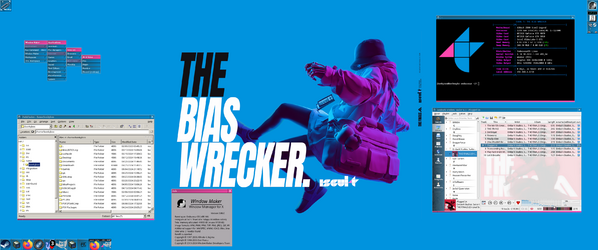Since we are talking about display protocols and the state of modern Linux desktops again, I figured I would share with you all that I'm experimenting with Windowmaker (and later, Afterstep) and liking it a lot so far... With strings attached. There is a catch.

Being based off of Nextstep, it's designed like a pseudo-DE: it's a plain and simple window manager at it's core, but it comes with the functionalities of a taskbar, and plugin support in the form of "dockapps". Most of these dockapps are ancient and not maintained very well, but if you manage to get them working, they can be extremely cool. I like this idea way more than simple tray icons (theres a dockapp to add those too, which you will probably need). You're going to want a few of these as they add lots of crucial functionality that you normally only get with a full DE. wmclock and wmtray are probably the most important.
Really, my only criticisms of this design are that:
A. You can't make the dock icons skinny like the KDE/Windows taskbar, which is specifically designed to reduce wasted space while being easy to click on without much precision. They can only be squares, and making these smaller than 64px sq. will fucking destroy most dockapps. So you either make the buttons huge or they will be busted in some way. Not a huge deal on a 1440p monitor, but on all my other computers, yeah that really stinks.
B. Organizing the dock icons is a little painful, a lot of things will require manual configuration, but really once you get the hang of it it makes a lot of sense. The only thing I don't like is that WM likes to hold onto icons for apps that are technically not open anymore, and keep duplicates (one for the process and one for every actual window) with no way to turn it off. You also can't set the default dock position to the bottom left without the WM fighting to put it in a separate column. I'm sure Afterstep has a fix for this, but not Windowmaker. No getting rid of the workspace switcher either. Not as elegant as a plain WM like Openbox. My workaround was to create a Drawer icon and "auto-attract" icons to it, which puts anything that isn't a minimized window away and out of sight. But then sometimes it gets mad because it's too dumb to figure out which program is which and wants you to tell it what command you tucked away.
C. Snapping to the edges of multi-monitor setups sometimes doesn't work, and windows appearing off-screen happens embarassingly often
D. There's no built-in way to see the user's programs list from ~/.local/, so moving your programs to the applications menu manually can be tedious on your first week.
E. Probably some other minor annoyances. Like the run box and a few others being sloppy.
But on the other hand, there's none of the KDE jank I frequently ran into when using Trinity. It's just as lightweight, if not more. Once you know how to tame it, it doesn't get in your way and it just kinda works. The theming system is incredible (see attachment) and in Afterstep it's even better. The Afterstep website even does a little party trick in this regard.
I'll keep using it for a bit and see if it's for me. I think the problems it has are things I can certainly tolerate.
